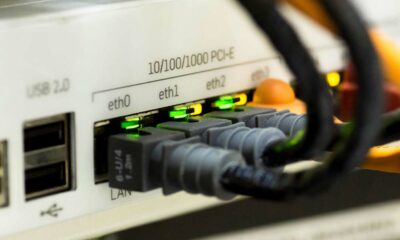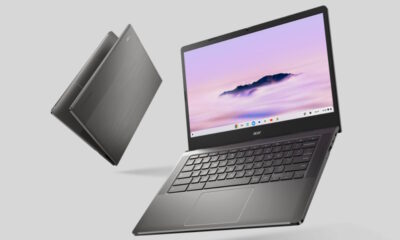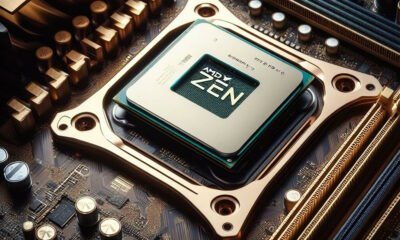Noticias
Intel Xeon E5-2600, una mala bestia de 8 núcleos

Aunque Ivy Bridge parece estar muy cerca de llegar al mercado en esta ocasión os mostramos la llegada de la familia Sandy Bridge Xeon E5-2600. Intel afirma que esta nueva línea de procesadores Xeon mejora en un 80% el rendimiento de la generación anterior mejorando el ratio de rendimiento por vatio un 50%.

La nueva familia llega con hasta 8 núcleos soportando hasta 768 Gbytes de RAM, PCIe 3.0, HyperThreading -hasta 16 hilos de proceso independientes-, TurboBoost y soporte Intel Virtualization. Es una gran familia con un total de 17 chips que van desde los 198$ hasta los 2.050 dólares.
Os dejamos todos los detalles de la familia Xeon E5-2600 chip en la nota de prensa adjunta.

[expand]
New Intel Server Technology: Powering the Cloud to Handle 15 Billion Connected Devices
New Intel® Xeon® Processor E5-2600 Product Family at Heart of a Flexible, Efficient Data Center
NEWS HIGHLIGHTS
New Intel® Xeon® processor E5-2600 product family is built to scale to meet the demands of an increasingly connected world.
New server processors deliver up to 80 percent1,2 improved performance compared to the prior generation.
New Intel® Integrated I/O with PCI Express* 3.0 can up to triple3 the movement of data into and out of the processor so information can be made available faster than ever to support data-hungry applications.
Best data center performance per watt with over 50 percent1,4 gain on SPECpower_ssj*2008 plus extends platform power control with Intel® Node Manager and Intel® Data Center Manager.
SANTA CLARA, Calif.–(BUSINESS WIRE)–Addressing the incredible growth of data traffic in the cloud, Intel Corporation announced the record-breaking Intel Xeon processor E5-2600 product family. These new processors deliver leadership performance, best data center performance per watt1,4, breakthrough I/O innovation and trusted hardware security features to enable IT to scale. These processors are not only at the heart of servers and workstations, but will also power the next generation of storage and communication systems from leading vendors around the world.
«For businesses to capitalize on these innovations, the industry must address unprecedented demand for efficient, secure and high-performing datacenter infrastructure. The Intel Xeon processor E5-2600 product family is designed to address these challenges by offering unparalleled, balanced performance across compute, storage and network, while reducing operating costs.»
Forecasts call for 15 billion connected devices5 and over 3 billion connected users6 by 2015. The amount of global data center IP traffic is forecasted to grow by 33 percent annually through 2015, surpassing 4.8 zetabytes per year, more than 3 times the amount in 20116. At these levels, each connected user will generate more than 4GB of data traffic every day – the equivalent of a 4-hour HD movie. This will increase the amount of data that needs to be stored by almost 50 percent per year7. In order to scale to meet this growth, the worldwide number of cloud servers is expected to more than triple by 20158.
«The growth in cloud computing and connected devices is transforming the way businesses benefit from IT products and services,» said Diane Bryant, Intel vice president and general manager of the Datacenter and Connected Systems Group. «For businesses to capitalize on these innovations, the industry must address unprecedented demand for efficient, secure and high-performing datacenter infrastructure. The Intel Xeon processor E5-2600 product family is designed to address these challenges by offering unparalleled, balanced performance across compute, storage and network, while reducing operating costs.»
The key requirements to enable IT to scale are performance, energy efficiency, I/O bandwidth and security. With the best combination of performance, built-in capabilities and cost-effectiveness, the new Intel Xeon processor E5-2600 product families are designed to address these requirements, and become the heart of the next-generation data center powering servers, storage and communication systems.
Leadership Performance with Best Data Center Performance per Watt
Supporting up to eight cores per processor and up to 768GB of system memory, the Intel Xeon processor E5-2600 product family increases performance by up to 80 percent1,2 compared to the previous-generation Intel® Xeon® processor 5600 series. The family also supports Intel® Advanced Vector Extension (Intel® AVX) that increases the performance on compute-intensive applications such as financial analysis, media content creation and high performance computing up to 2 times9.
Additional built-in technologies such as Intel® Turbo Boost Technology 2.0, Intel Hyper-Threading Technology and Intel® Virtualization Technology provide IT with flexible capabilities to increase the performance of their infrastructure dynamically. These performance advances have led the Intel Xeon processor E5-2600 product family to capture 1510 new dual socket x86 world records.
Modern data centers must improve the raw performance they deliver, but also do so efficiently by reducing power consumption and operating costs. The Intel Xeon processor E5-2600 product family continue Intel’s focus on reducing total cost of ownership by improving energy efficient performance more than 50 percent1,4 as measured by SPECpower_ssj*2008 compared to the previous generation Intel Xeon processor 5600 series. These processors offer support for tools to monitor and control power usage such as Intel® Node Manager and Intel® Data Center Manager, which provide accurate, real-time power and thermal data to system management consoles. In addition, Intel’s leadership performance allows IT managers to meet their growing demands while optimizing software license and capital costs.
I/O Innovation and Network Capabilities
With the unprecedented growth in data traffic it is essential that systems not only improve computational abilities, but also enable data to flow faster to support data-hungry applications and increase the bandwidth within the data center. The Intel Xeon processor E5-2600 product family meets these needs with Intel® Integrated I/O (Intel® IIO) and Intel® Data Direct I/O (Intel® DDIO). Intel® DDIO allows Intel Ethernet controllers and adapters to route I/O traffic directly to processor cache, reducing trips to system memory reducing power consumption and I/O latency. The Intel Xeon processor E5-2600 product family is also the first server processors to integrate the I/O controller supporting PCI Express* 3.0 directly into the microprocessor. This integration reduces latency up to 30 percent11 compared to prior generations and with PCI Express* 3.0 can up to triple3 the movement of data into and out of the processor.
The high-performance processing power along with Intel® Integrated I/O and advanced storage features such as PCIe* non-transparent bridging and asynchronous DRAM refresh, makes the Intel Xeon processor E5-2600 product family also an ideal choice for storage and communications solutions.
Increasing bandwidth demands driven by server virtualization and data and storage network consolidation have led to strong growth in 10 Gigabit Ethernet deployments, with adapter port shipments exceeding 1 million units in each quarter of 201113. Today’s announcement of the Intel® Ethernet Controller X540 demonstrates Intel’s commitment to driving 10 Gigabit Ethernet to the mainstream by reducing implementation costs. This industry-first single-chip 10GBASE-T solution is designed for low-cost, low-power LAN on motherboard (LOM) and includes flexible I/O Virtualization and Unified networking support at no additional cost.
Trusted Security
The Intel Xeon processor E5-2600 product family reaffirms Intel’s commitment to providing a more secure hardware foundation for today’s data centers. Intel® Advanced Encryption Standard New Instruction (Intel® AES-NI14) helps systems to quickly encrypt and decrypt data running over a range of applications and transactions. Intel® Trusted Execution Technology (Intel® TXT15) creates a trusted foundation to reduce the infrastructure exposure to malicious attacks. These features in partnership with leading software applications will help IT protect their data centers against attack and scale to meet the demands of their customers.
Extensive Industry Support
Starting today, system manufacturers from around the world are expected to announce hundreds of Intel® Xeon® processor E5 family-based platforms. These manufacturers include Acer*, Appro*, Asus*, Bull*, Cisco*, Dell*, Fujitsu*, HP*, Hitachi*, Huawei*, IBM*, Inspur*, Lenovo*, NEC*, Oracle*, Quanta*, SGI*, Sugon*, Supermicro* and Unisys*.
Product, Pricing Details
The Xeon processor E5-2600 product family will be offered with 17 different parts which range in price from $198 to $2,050 in quantities of 1,000. Additionally three single-socket Intel Xeon processor E5-1600 parts will be offered for workstations which range in price from $284 to $1,080. Complete pricing details can be found in the Intel Newsroom. For more details on these new Intel Xeon processors, visit www.intel.com/xeon. For more details on world records and other claims, visit www.intel.com/performance/server/.
About Intel
Intel (NASDAQ:INTC) is a world leader in computing innovation. The company designs and builds the essential technologies that serve as the foundation for the world’s computing devices. Additional information about Intel is available at newsroom.intel.com and blogs.intel.com.
Intel, Intel Xeon and the Intel logo are trademarks of Intel Corporation in the United States and other countries.
* Other names and brands may be claimed as the property of others.
1 Software and workloads used in performance tests may have been optimized for performance only on Intel microprocessors. Performance tests, such as SYSmark and MobileMark, are measured using specific computer systems, components, software, operations and functions. Any change to any of those factors may cause the results to vary. You should consult other information and performance tests to assist you in fully evaluating your contemplated purchases, including the performance of that product when combined with other products. For more information go to www.intel.com/performance
2 (Generational Performance) Source: Performance comparison using best submitted/published 2-socket server results on the SPECfp*_rate_base2006 benchmark as of 6 March 2012. Baseline score of 271 published by Itautec on the Servidor Itautec MX203* and Servidor Itautec MX223* platforms based on the prior generation Intel® Xeon® processor X5690. New score of 492 submitted for publication by Dell on the PowerEdge T620 platform and Fujitsu on the PRIMERGY RX300 S7* platform based on the Intel® Xeon® processor E5-2690. For additional details, please visit www.spec.org.16.
3 (I/O Bandwidth) Source: Intel internal measurements of maximum achievable I/O R/W bandwidth (512B transactions, 50% reads, 50% writes) comparing Intel® Xeon® processor E5-2680 based platform with 64 lanes of PCIe* 3.0 (66 GB/s) vs. Intel® Xeon® processor X5670 based platform with 32 lanes of PCIe* 2.0 (18 GB/s). Baseline Configuration: Green City system with two Intel® Xeon® processor X5670 (2.93 GHz, 6C), 24GB memory @ 1333, 4 x8 Intel internal PCIe* 2.0 test cards. New Configuration: Rose City system with two Intel® Xeon processor E5-2680 (2.7GHz, 8C), 64GB memory @1600 MHz, 2 x16 Intel internal PCIe* 3.0 test cards on each node (all traffic sent to local nodes).
4 (Energy Efficient Performance) Source: Performance comparison using best submitted/published 2-socket single-node server results on the SPECpower_ssj*2008 benchmark as of 6 March 2012. Baseline score of 3,329 ssj*_ops/watt published by Hewlett-Packard on the ProLiant DL360 G7* platform based on the prior generation Intel® Xeon® processor X5675. Score of 5,093 ssj*_ops/watt submitted for publication by Fujitsu on the PRIMERGY RX300 S7* platform based on the Intel® Xeon® processor E5-2660. For additional details, please visit www.spec.org.1,16.
5 (Connect devices) Source: «Worldwide Device Estimates Year 2020 – Intel One Smart Network Work» forecast
6 (datacenter traffic forecast) Source: Cisco® Global Cloud Index: Forecast and Methodology 2010 – 2015. http://www.cisco.com/en/US/solutions/collateral/ns341/ns525/ns537/ns705/ns1175/Cloud_Index_White_Paper.html
7 (Data Storage) Source: «IDC Worldwide Enterprise Storage Systems 2010-2014 Forecast»
8 (Cloud system) Intel internal projections of cloud market growth between 2011 and 2015
9 (AVX) Source: Performance comparison using Linpack benchmark. Baseline score of 159.4 based on Intel internal measurements as of 5 December 2011 using a Supermicro* X8DTN+ system with two Intel® Xeon® processor X5690, Turbo Enabled, EIST Enabled, Hyper-Threading Enabled, 48 GB RAM, Red Hat* Enterprise Linux Server 6.1. New score of 347.7 based on Intel internal measurements as of 5 December 2011 using an Intel® Rose City platform with two Intel® Xeon® processor E5-2690, Turbo Enabled or Disabled, EIST Enabled, Hyper-Threading Enabled, 64 GB RAM, Red Hat* Enterprise Linux Server 6.1.16.
10 (World Record Performance) Source: Best available submitted/published performance benchmark results on 2S x86 server platforms as of 6 March 2012. For a full summary of world record performance results, please visit www.intel.com/content/www/us/en/benchmarks/server/xeon-e5-2600-summary.html. For additional details, please visit www.spec.org, www.sap.com/solutions/benchmark, www.vmware.com/a/vmmark, and www.tpc.org.
11 (I/O Latency) Source: Intel internal measurements of average time for an I/O device read to local system memory under idle conditions comparing the Intel® Xeon® processor E5-2600 product family (230 ns) vs. the Intel® Xeon® processor 5500 series (340 ns). Baseline Configuration: Green City system with two Intel® Xeon® processor E5520 (2.26GHz, 4C), 12GB memory @ 1333, C-States Disabled, Turbo Disabled, SMT Disabled. New Configuration: Meridian system with two Intel® Xeon® processor E5-2665 (2.4GHz, 8C), 32GB memory @1600 MHz, C-States Enabled, Turbo Enabled. The measurements were taken with a LeCroy* PCIe* protocol analyzer using Intel internal Rubicon (PCIe* 2.0) and Florin (PCIe* 3.0) test cards running under Windows* 2008 R2 w/SP1.
12 (PCIe* 3.0) Source: 8 GT/s and 128b/130b encoding in PCIe* 3.0 specification enables double the interconnect bandwidth over the PCIe* 2.0 specification (www.pcisig.com/news_room/November_18_2010_Press_Release/ ). Intel internal measurements of maximum achievable I/O R/W bandwidth (512B transactions, 50% reads, 50% writes) using Xeon® processor E5-2680 based platform. Configuration: Rose City system with two Intel® Xeon processor E5-2680 (2.7GHz, 8C), 64GB memory @1600 MHz, 2 x16 Intel internal PCIe* 3.0 test cards on each node (all traffic sent to local nodes).
13 (10GBe) Crehan Research: Server-class Adapter and LOM Market 4Q10
14 (AES-NI) Intel® AES-NI requires a computer system with an AES-NI enabled processor, as well as non-Intel software to execute the instructions in the correct sequence. AES-NI is available on select Intel® processors. For availability, consult your reseller or system manufacturer. For more information, see http://software.intel.com/en-us/articles/intel-advanced-encryption-standard-instructions-aes-ni/
15 (TXT) No computer system can provide absolute security under all conditions. Intel® Trusted Execution Technology (Intel® TXT) requires a computer with Intel® Virtualization Technology, an Intel TXT-enabled processor, chipset, BIOS, Authenticated Code Modules and an Intel TXT-compatible measured launched environment (MLE). Intel TXT also requires the system to contain a TPM v1.s. For more information, visit http://www.intel.com/technology/security
16 Intel does not control or audit the design or implementation of third party benchmark data or Web sites referenced in this document. Intel encourages all of its customers to visit the referenced Web sites or others where similar performance benchmark data are reported and confirm whether the referenced benchmark data are accurate and reflect performance of systems available for purchase.
[/expand]
-

 NoticiasHace 3 días
NoticiasHace 3 díasRequisitos de Ghost of Tsushima, llegará a PC el 16 de mayo con DLSS 3 y FSR 3
-

 A FondoHace 6 días
A FondoHace 6 díasFin de ADSL, ¿qué alternativas tienes?
-

 AnálisisHace 6 días
AnálisisHace 6 díasASUS ROG Zephyrus G14 2024, análisis
-

 A FondoHace 3 días
A FondoHace 3 díasLas mejores alternativas a la Google Play Store para descargar apps Android























